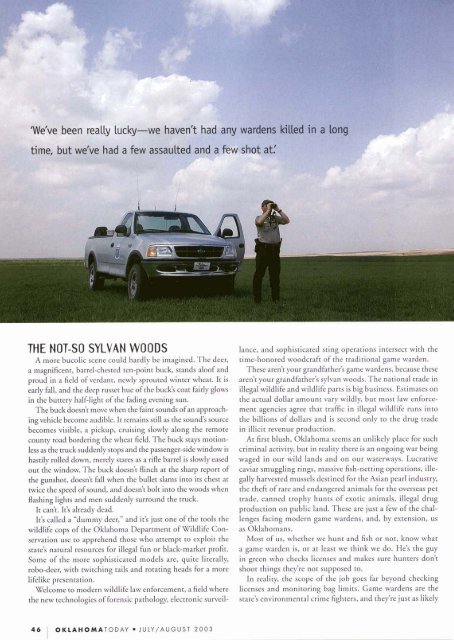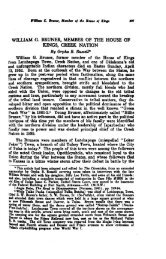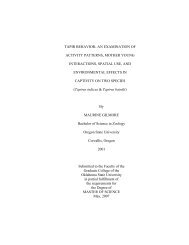Oklahoma Today July-August 2003 Volume 53 No. 4
Oklahoma Today July-August 2003 Volume 53 No. 4
Oklahoma Today July-August 2003 Volume 53 No. 4
Create successful ePaper yourself
Turn your PDF publications into a flip-book with our unique Google optimized e-Paper software.
THE NOT-SO SYLVAN WOODS<br />
A more bucolic scene could hardly be imagined. The deer,<br />
a magnificent, barrel-chested ten-point buck, stands aloof and<br />
proud in a field of verdant, newly sprouted winter wheat. It is<br />
early fall, and the deep russet hue of the buck's coat fairly glows<br />
in the buttery half-light of the fading evening sun.<br />
The buck doesn't move when the faint sounds of an approaching<br />
vehicle become audible. It remains still as the sound's source<br />
becomes visible, a pickup, cruising slowly along the remote<br />
county road bordering the wheat field. The buck stays motionless<br />
as the truck suddenly stops and the passenger-side window is<br />
hastily rolled down, merely stares as a rifle barrel is slowly eased<br />
out the window. The buck doesn't flinch at the sharp report of<br />
the gunshot, doesn't fall when the bullet slams into its chest at<br />
twice the speed of sound, and doesn't bolt into the woods when<br />
flashing lights and men suddenly surround the truck.<br />
It can't. It's already dead.<br />
It's called a "dummy deer," and it's just one of the tools the<br />
wildlife cops of the <strong>Oklahoma</strong> Department of Wildlife Conservation<br />
use to apprehend those who attempt to exploit the<br />
state's natural resources for illegal fun or black-market profit.<br />
Some of the more sophisticated models are, quite literally,<br />
robo-deer, with twitching tails and rotating heads for a more<br />
lifelike presentation.<br />
Welcome to modern wildlife law enforcement, a field where<br />
the new technologies of forensic pathology, electronic surveil-<br />
lance, and sophisticated sting operations intersect with the<br />
time-honored woodcraft of the traditional game warden.<br />
These aren't your !grandfather's game wardens, because these<br />
aren't your grandfather's sylvan woods. The national trade in<br />
illegal wildlife and wildlife parts is big business. Estimates on<br />
the actual dollar amount vary wildly, but most law enforcement<br />
agencies agree that traffic in illegal wildlife runs into<br />
the billions of dollars and is second only to the drug trade<br />
in illicit revenue production.<br />
At first blush, <strong>Oklahoma</strong> seems an unlikely place for such<br />
criminal activity, but in reality there is an ongoing war being<br />
waged in our wild lands and on our waterways. Lucrative<br />
caviar smuggling rings, massive fish-netting operations, illegally<br />
harvested mussels destined for the Asian pearl industry,<br />
the theft of rare and endangered animals for the overseas pet<br />
trade, canned trophy hunts of exotic animals, illegal drug<br />
production on public land. These are just a few of the challenges<br />
facing modern game wardens, and, by extension, us<br />
as <strong>Oklahoma</strong>ns.<br />
Most of us, whether we hunt and fish or not, know what<br />
a game warden is, or at least we think we do. He's the guy<br />
in green who checks licenses and makes sure hunters don't<br />
shoot things they're not supposed to.<br />
In reality, the scope of the job goes far beyond checking<br />
licenses and monitoring bag limits. Game wardens are the<br />
state's environmental crime fighters, and they're just as likely<br />
46 1 OKLAHOMATODAY .JULY/AUGUST <strong>2003</strong>
















